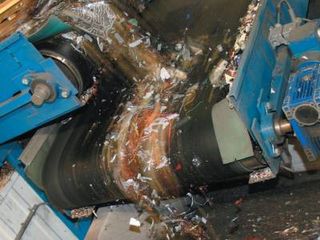What's happening to all the CRT TVs?
The classic CRT is not quite as dead as you might think

Where have all the CRT televisions gone? In the global rush to junk these 20th Century TVs in favour of slim, HD-ready LCD and plasma displays, you'd think that the classic, bulky CRT is all but obsolete.
But you'd be wrong. The low cost of CRTs still makes them wildly popular in China, Latin America, Asia and the Middle East. While the big TV manufacturers have stopped making their own CRT-based sets, some are still selling them. Sony, for example, still lists a wide range of CRT TVs on its Middle East & Africa website.
And, as we'll see, their components are also being given new lives, thanks to stringent recycling arrangements here and in the rest of the EU.
Fare thee well cathode ray tube...
The invention of the cathode ray tube in 1897 is what originally made television possible. Scottish inventor John Logie Baird is credited with the first demonstration of this TV technology in 1925.
84 years on and the CRT TV is now a dying breed. In the UK, many of us still own one. This writer has a colossal Toshiba 2857DB, still working after 10 years, and a hardy 14-inch portable (plugged into a Freeview box) in the kitchen.
But the boom in digital TV and high-definition (PS3/Xbox 360 gaming, HD TV and Blu-ray) is accelerating the switch to newer, flat-screen models. And these are getting cheaper all the time.
Get daily insight, inspiration and deals in your inbox
Get the hottest deals available in your inbox plus news, reviews, opinion, analysis and more from the TechRadar team.
How to get rid of a CRT TV
So what can you do with your old CRT TV if you do want rid of it? You could give it away for free, trade it in against the purchase of a new TV (if you can find a suitable offer) or try to sell it for peanuts on eBay.
Of course, most old TVs get dumped. But rather than end up in a landfill, they're now being recycled according to the Waste Electrical and Electronic Equipment (WEEE) Directive, which came into force in January 2007.
Under a watchful WEEE, two things can happen. "When you take an electrical item to your local SORT IT! Centre," a spokesperson for South Gloucestershire council told us, "it will either be sent for reuse or, if it is not in near-to-working order, for recycling."
Over at the Recycling Lives website you can type in your postcode to see where your nearest recycling centre is and what types of waste they process.
This is where old CRTs go to die...
Our spokesman from South Gloucestershire told us that all TVs are sent away to the Sims Group in South Wales for reprocessing. Here the TVs "are dismantled by hand on work benches and the main glass CRT tube must be split in two," explains David Robertson, Recycling and PR Manager for SITA South Gloucestershire.
"This is because the back [of the CRT] is coated in lead (environmentally toxic) and the front is coated with phosphor. The two pieces are then recycled in different ways to sort the glass from the chemicals. All the other components are recycled along with the plastics and metal casings."
At the end of the process, all of the constituent materials in a CRT TV can be reused. Circuit boards, for example, contain precious metals and any steel recovered can be re-used. Leaded glass is reclaimed and sold on to the small Asian OEMs that still produce new CRT sets.
Recycled plastics can eventually be used in a wide variety of new products such as polyethylene bin liners, carrier bags, compact disc cases, garden furniture, water butts and even fibre filling for sleeping bags.
The only remaining advantage of CRT
Worldwide, the writing is on the wall for CRT. Production is certainly dipping. According to the most recent hard data from DisplaySearch, CRT shipments totalled 23 million units in Q3 2008, down 15 per cent from 2007's numbers.
But when you compare this to the 26 million LCDs and almost 4 million plasmas that were shipped in the same time period, you can see that CRT technology is still hanging in there.
The key to CRT's staying power (at least for now) is price. In China, Latin America, Asia and the Middle East, flat-panel prices are still too high for many consumers. But once LCD prices fall, nothing will save CRT from ending up alongside cassettes, Teletypes and HD DVD in the technology dustbin.
-------------------------------------------------------------------------------------------------------
Now read 15 great uses for your old PC
Sign up for the free weekly TechRadar newsletter
Get tech news delivered straight to your inbox. Register for the free TechRadar newsletter and stay on top of the week's biggest stories and product releases. Sign up at http://www.techradar.com/register
Most Popular

